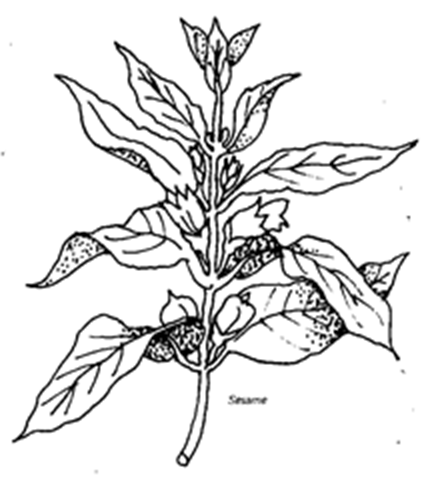Common name: sesame Botanical name: Sesamum
indicum Origin: Africa
Varieties
Few varieties are available; grow the variety available in your area.
Description
Sesame is a hardy annual that has a unique drought-tolerant root system composed of a long taproot and a large number of fibrous secondary roots. It’s an attractive plant, with cream or pale orchid-colored flowers that grow in the angles of the leaves. Sesame used to be credited with magic powers and was associated with Hecate, queen of witches. Its uses today are less dramatic; the dried seeds are used to flavor breads, candy, and baked goods, and the oil extracted from the

seeds is used for cooking and in salad dressings.
Where and when to grow
Sesame is easy to grow if you can give it a growing season of about 120 days; it grows well in the warm, dry areas of the South and Southwest. Plant it when danger of frost is over.
How to plant
Give sesame a place in the sun in well-drained, fertile soil. When you’re preparing the soil, dig in a complete, well-balanced fertilizer at the rate of one pound per 100 square feet. Four to six weeks after the average date of last frost, plant the seeds a half inch deep in rows 12 to 18 inches apart. Thin the plants to 12 to 18 inches apart when they are four to five weeks old.
Fertilizing and watering
Fertilize before planting and again at midseason, at the same rate as the rest of the garden. Detailed information on fertilizin is given in “Spadework: The Essential Soil” in Parti.Allow the plants to dry out between waterings.
Pests
Sesame has no serious pest problems.
Diseases
Sesame has no serious disease problems.
When and how to harvest
Harvest about 90 to 120 days after planting when the mature seed pods are about the size of a peanut. Crack the pods open carefully, and remove the seeds.
Storing and preserving
Store the dried sesame seeds in an airtight container. Detailed information on storing and preserving is given in Part 3.
Serving suggestions
Toast sesame seeds and toss them over vegetable dishes or soups. They give an extra crunch to pan-fried fish. Or, just eat the roasted seeds as a snack. Sesame is used a lot in Oriental dishes and the seeds, untoasted, are added to cookies, cakes, and breads before baking.
